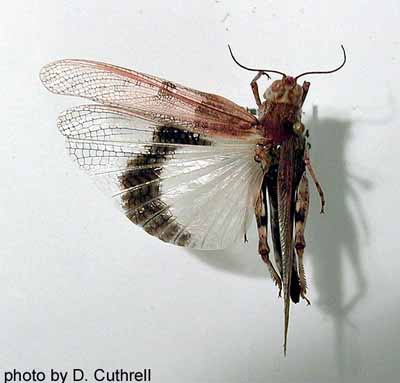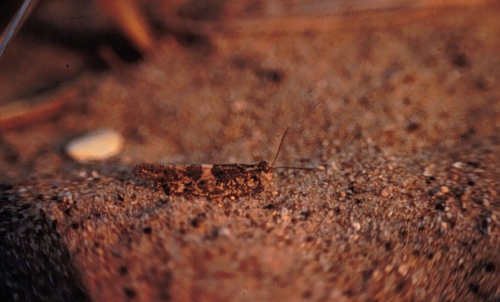Plants and Animals
Trimerotropis huroniana Lake Huron locust
Key Characteristics
The Lake Huron locust is a small ash-gray grasshopper with darker brown and white markings and wings with a prominent dark band. The pronutum (saddle-like structure behind the head) is cut by two narrow grooves (sulci), and a broad (not narrow) black band covers half the inner surface of the hind femora near the body.
Status and Rank
US Status: No Status/Not Listed
State Status: T - Threatened (legally protected)
Global Rank: G4 - Apparently secure
State Rank: S2S3 - Rank is uncertain, ranging from imperiled to vulnerable
Occurrences
| County | Number of Occurrences | Year Last Observed |
|---|---|---|
| Alcona | 4 | 2010 |
| Alger | 2 | 1997 |
| Alpena | 2 | 1996 |
| Antrim | 2 | 2009 |
| Benzie | 4 | 2009 |
| Charlevoix | 16 | 2015 |
| Cheboygan | 3 | 1996 |
| Chippewa | 4 | 1997 |
| Emmet | 9 | 2011 |
| Huron | 1 | 1924 |
| Iosco | 2 | 1996 |
| Leelanau | 4 | 2009 |
| Luce | 4 | 1997 |
| Mackinac | 16 | 2006 |
| Manistee | 3 | 1996 |
| Mason | 2 | 1996 |
| Presque Isle | 4 | 1996 |
| Schoolcraft | 11 | 2006 |
Information is summarized from MNFI's database of rare species and community occurrences. Data may not reflect true distribution since much of the state has not been thoroughly surveyed.
Habitat
This species occurs only in sparsely vegetated, high-quality Great Lakes sand dunes along northern Lake Michigan, northern Lake Huron, and eastern Lake Superior. Ideal habitat includes at least a mile of shoreline with two or more sets of dunes with blowouts. It primarily feeds on dune grass, beach grass, and wormwood, but will eat other forbs also, including the federally threatened pitcher's thistle (Cirsium pitcheri).
Specific Habitat Needs
Sandy substrate needed in: Open dunes.
Natural Community Types
For each species, lists of natural communities were derived from review of the nearly 6,500 element occurrences in the MNFI database, in addition to herbarium label data for some taxa. In most cases, at least one specimen record exists for each listed natural community. For certain taxa, especially poorly collected or extirpated species of prairie and savanna habitats, natural community lists were derived from inferences from collection sites and habitat preferences in immediately adjacent states (particularly Indiana and Illinois). Natural communities are not listed for those species documented only from altered or ruderal habitats in Michigan, especially for taxa that occur in a variety of habitats outside of the state.
Natural communities are not listed in order of frequency of occurrence, but are rather derived from the full set of natural communities, organized by Ecological Group. In many cases, the general habitat descriptions should provide greater clarity and direction to the surveyor. In future versions of the Rare Species Explorer, we hope to incorporate natural community fidelity ranks for each taxon.
Management Recommendations
Protection of remaining dune habitat is critical, especially from development and ORV use. Species does not survive well in weedy habitat or disturbed sites where dune dynamics are altered through complete removal of vegetation.
Active Period
Active from second week of July to second week of October
Survey Methods
The species is most active in late morning, after 9:30 or 10. Males crepitate in flight, making a cracking noise.
Visual, auditory, net
Survey Period: From second week of July to second week of October
Time of Day: Morning (after sunrise)
References
Survey References
- Borror, D.J. and R.E. White. 1970. A Field Guide to the Insects of North America and Mexico. Houghton Mifflin Company, Boston. 404pp.
- Martin, J.E.H. 1977. The Insects and Arachnids of Canada (Part 1): Collecting, preparing, and preserving insects, mites, and spiders. Publication 1643. Biosystematics Research Institute, Ottawa.
Technical References
- Bland, R.G. 2003. The Orthoptera of Michigan: Biology, Keys, and Descriptions of Grasshoppers, Katydids, and Crickets. Michigan State University Extension, East Lansing. Extension Bulletin E-2815. 220pp.
- Dunn, G.A. 1999. Insects of the Great Lakes Region. University of Michigan Press, Ann Arbor. 324pp.
- Evers, D.C. 1994. Endangered and Threatened Wildlife of Michigan. The University of Michigan Press, Ann Arbor. 412pp.
- Rabe, M.L. 1999. Special Animal Abstract for Trimerotropis huroniana (Lake Huron locust). Michigan Natural Features Inventory, Lansing, MI 3pp.



